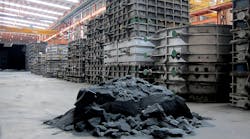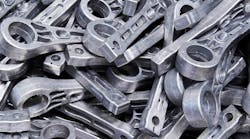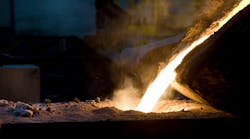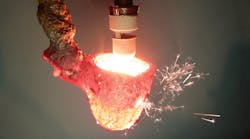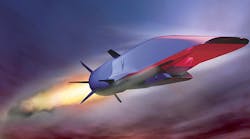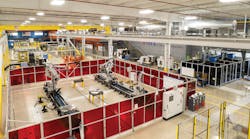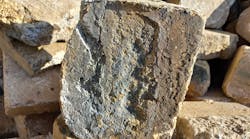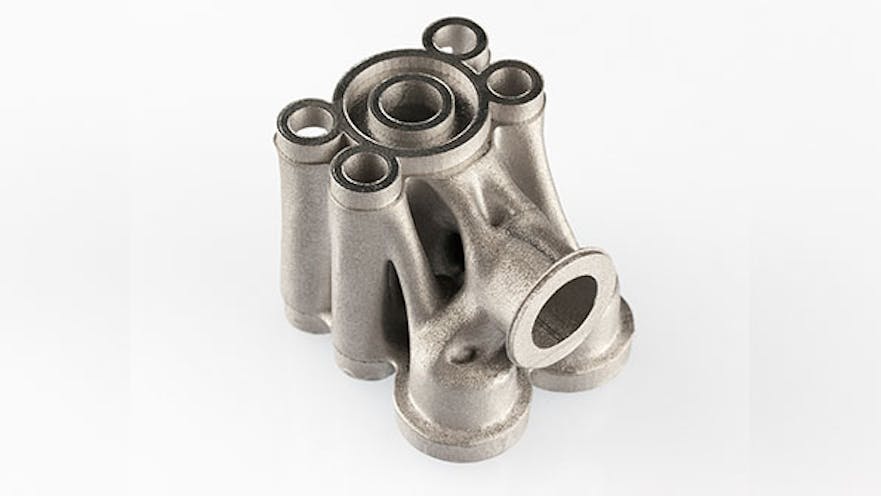Additive manufacturing methods are making steady progress, challenging conventional forming methods
The progress of additive manufacturing methods in completing finished component parts is steadily challenging standard production processes, like metalcasting. One reason for this: the wide availability of AM technologies has made it possible for multiple researchers to engage in purpose-driven research, resolving problems in particular cases that, incrementally, improve the overall prospects.
AM, or 3D printing, is a catchall for various production methods (laser sintering, stereo lithography, etc.) that transfer information from CAD into structural form. The limitations are defined only by the physical nature of the design or the applicability of the chosen manufacturing system.
For example, the VTT Technical Research Centre of Finland Ltd. and Nurmi Cylinders Oy developed a 3D-printed hydraulic valve that they claim is cost-efficient to produce, reliable in performance, and 66% lighter than the original part. The valve is used to control fluid in hydraulic cylinders in motion control systems for heavy machinery — cranes, for example.
The original valve block’s concept was redefined to take advantage of 3DP’s ability to optimize weight, mass, and material volume, thus improving the original design. Typically, the internal channels of the block are created with straight, circular drilling in solid material. Several auxiliary passages need to be drilled too, and though these may be plugged they create the possibility of fluid leaks.
Using 3D printing, the internal channels can be optimized to achieve the best possible flow of hydraulic fluid, and save space, while the potential for leakage is eliminated without auxiliary drilling.
Last November, VTT and Tekes (the Finnish federal department funding technology and research) initiated a $3.5-million, two-year public/private effort to establish new businesses that use AM technology. The program coordinates of the companies’ own projects with research conducted by VTT.
The hydraulic valve block is a critical part, though small. Chicago-based Sciaky Inc. is quickly expanding the dimensional capabilities of its “electron beam additive manufacturing” (EBAM) process, which it calls the “most widely scalable” metal 3D printing method available — meaning it has the largest work envelope, for parts ranging from 8 in. to 19 ft. long.
It also boasts that EBAM is the fastest metal deposition process available, with gross deposition rates ranging from 7 to 20 lb./hr. (3.18 to 9.07 kg/hr.) of metal. Moreover, the system is capable of a dual wire-feed set-up, to combine two metal alloys — titanium, tantalum, niobium, tungsten, molybdenum, Inconel, aluminum, stainless steels, nickel alloys, and more are possible — in a single melt pool, or the materials can be “graded” as desired to different parts of a single structure.
The science of metal 3DP need not involve lasers: NanoSteel Co. Inc., which puts its additive manufacturing emphasis on “nano-structured steel materials”, introduced two powdered alloy materials for binder-jetting. That’s the AM process in which the material is deposited in sequential layers, bound together by an epoxy, until the completed form can be oven-heated to fuse the layers as a single structure. It’s recognized for having a faster building speed than laser-based sintering methods.
NanoSteel’s new materials (BLDRmetal™ J-10 and J-11) are offered for printing components needed in highly abrasive applications, applications that will benefit from the option to produce complex designs without tooling, and on-demand. It said components made using J-10 feature twice the elongation and three times the wear and impact resistance of an equivalently infiltrated 420 stainless steel.
NanoSteel demonstrated the materials in projects with 3DX Industries, an AM service provider, to print a security tool used by an avionics company to remove aircraft panels. Tools made with J-10 lasted five times longer than the previous versions, significantly decreasing the risk of delays in servicing aircraft.
“The NanoSteel solution enabled us to create a tool that delivered the durability and reliability the customer required in a fast turnaround environment,” according to Roger Janssen, 3DX president and CEO.
Both materials are based on a combination of complex metallic phases that provide wear resistance and a steel matrix that delivers ductility and toughness. BLDRmetal J-11 is designed for extreme-wear/low-impact applications. Components formed in J-11 provide 10 times the wear resistance of an equivalently infiltrated 420 stainless steel, according to the developer.
“These first BLDRmetal powders offer compelling alternatives to existing materials for the binder jet printing process,” stated Harald Lemke, general manager and vice president of Engineered Powders at NanoSteel. “The company’s entry into the market enhances the applicability of binder jet printing by enabling the additive manufacturing of high-complexity, lower-cost components with exceptional wear performance.”

